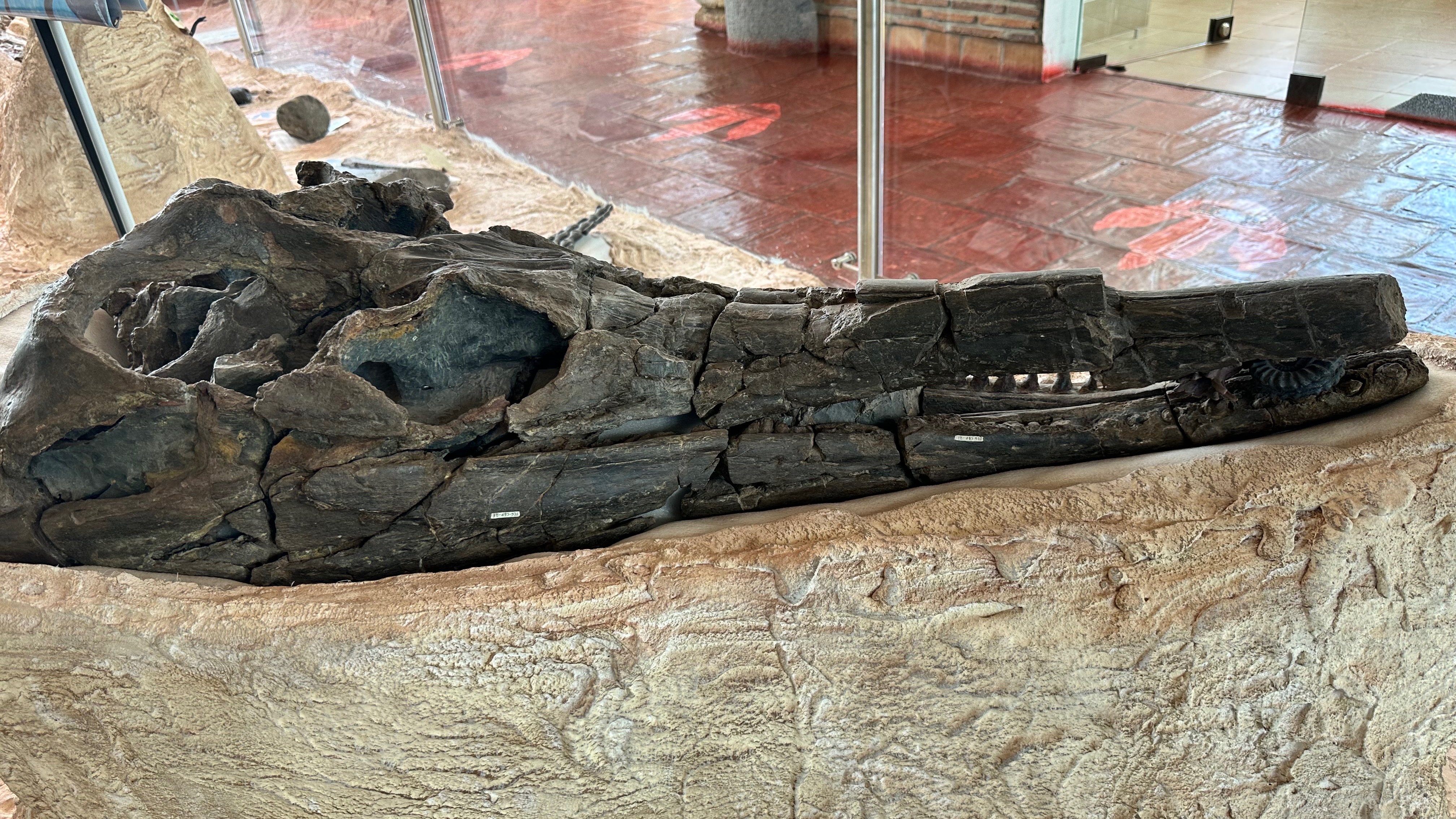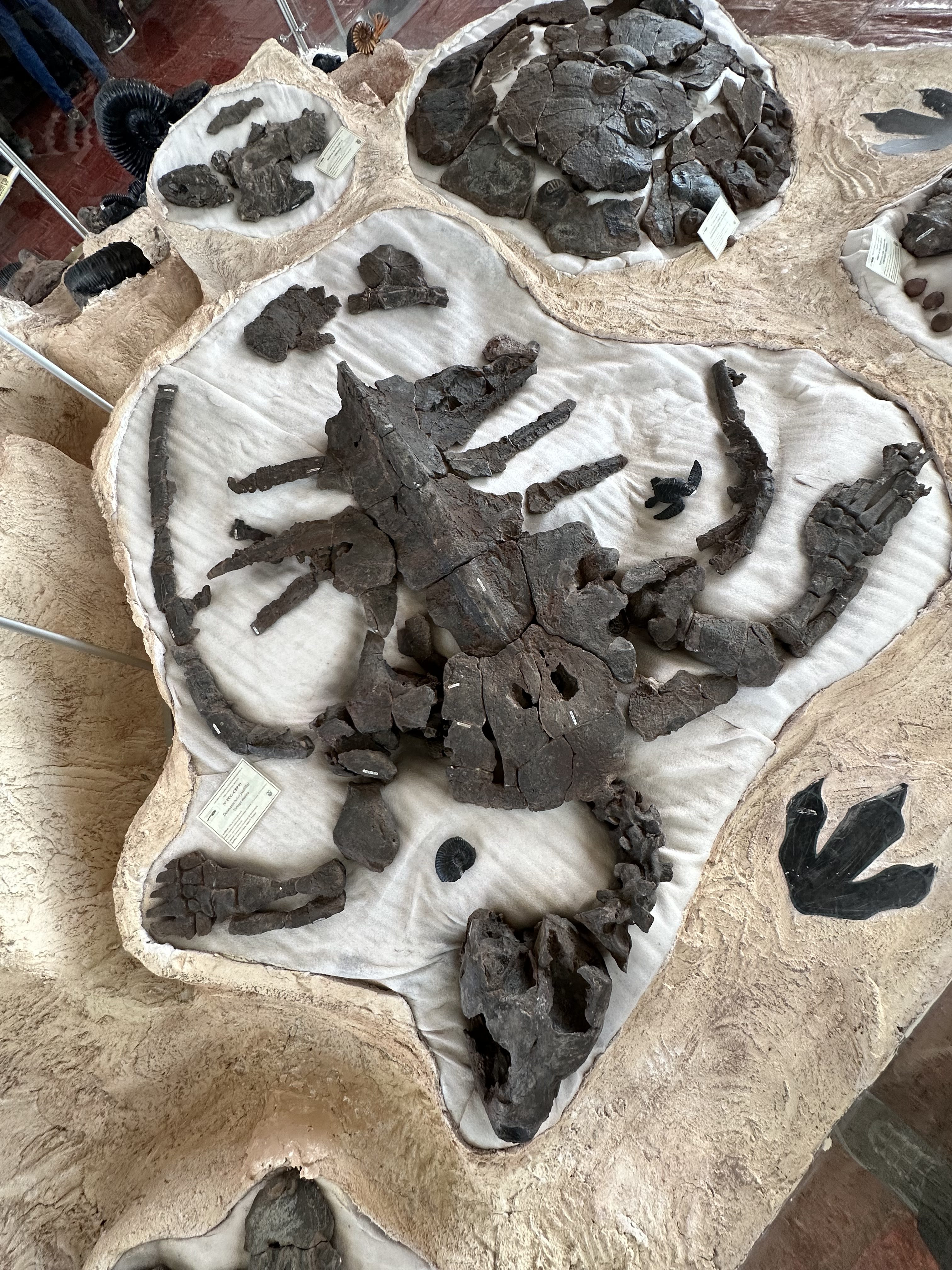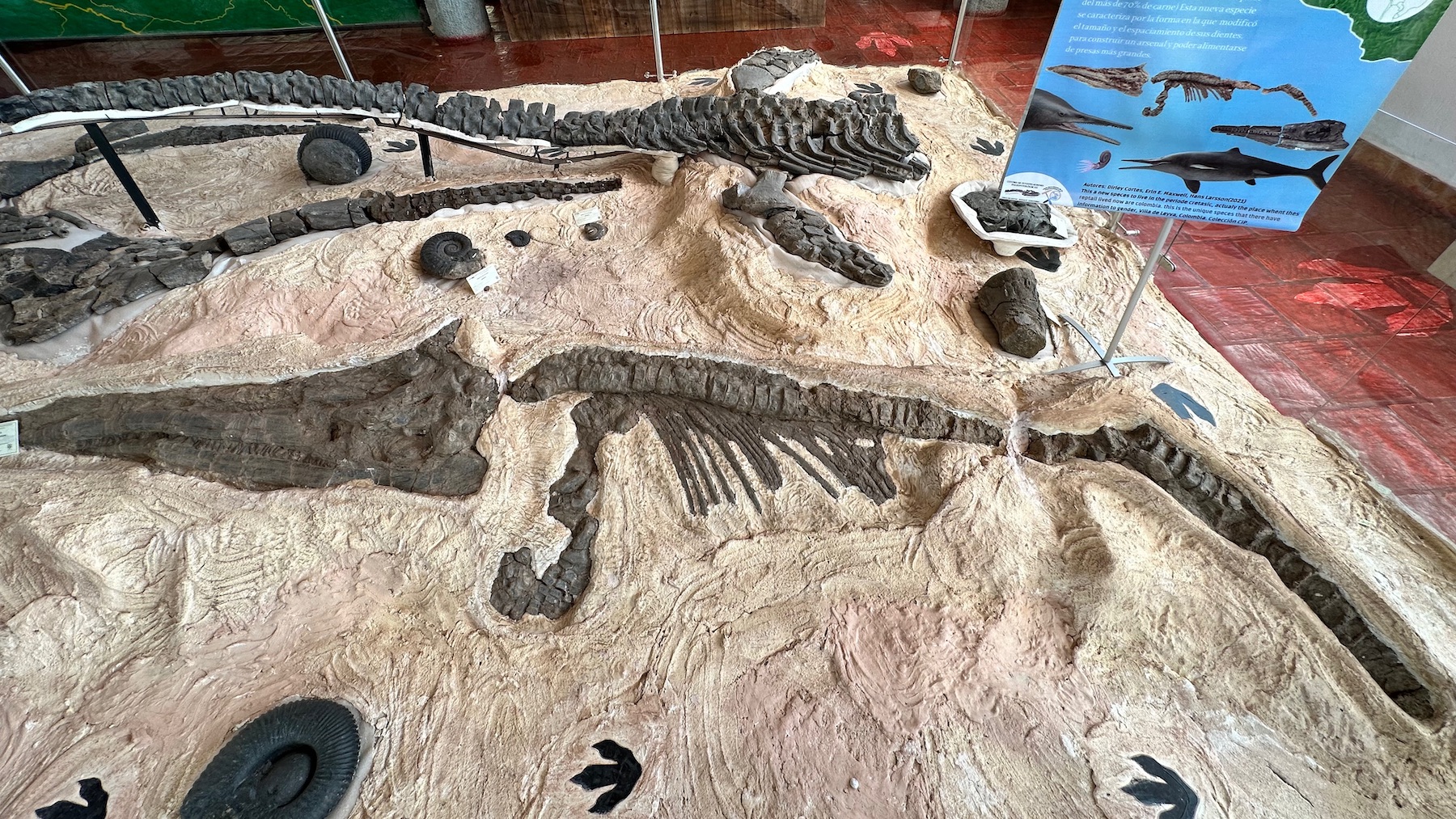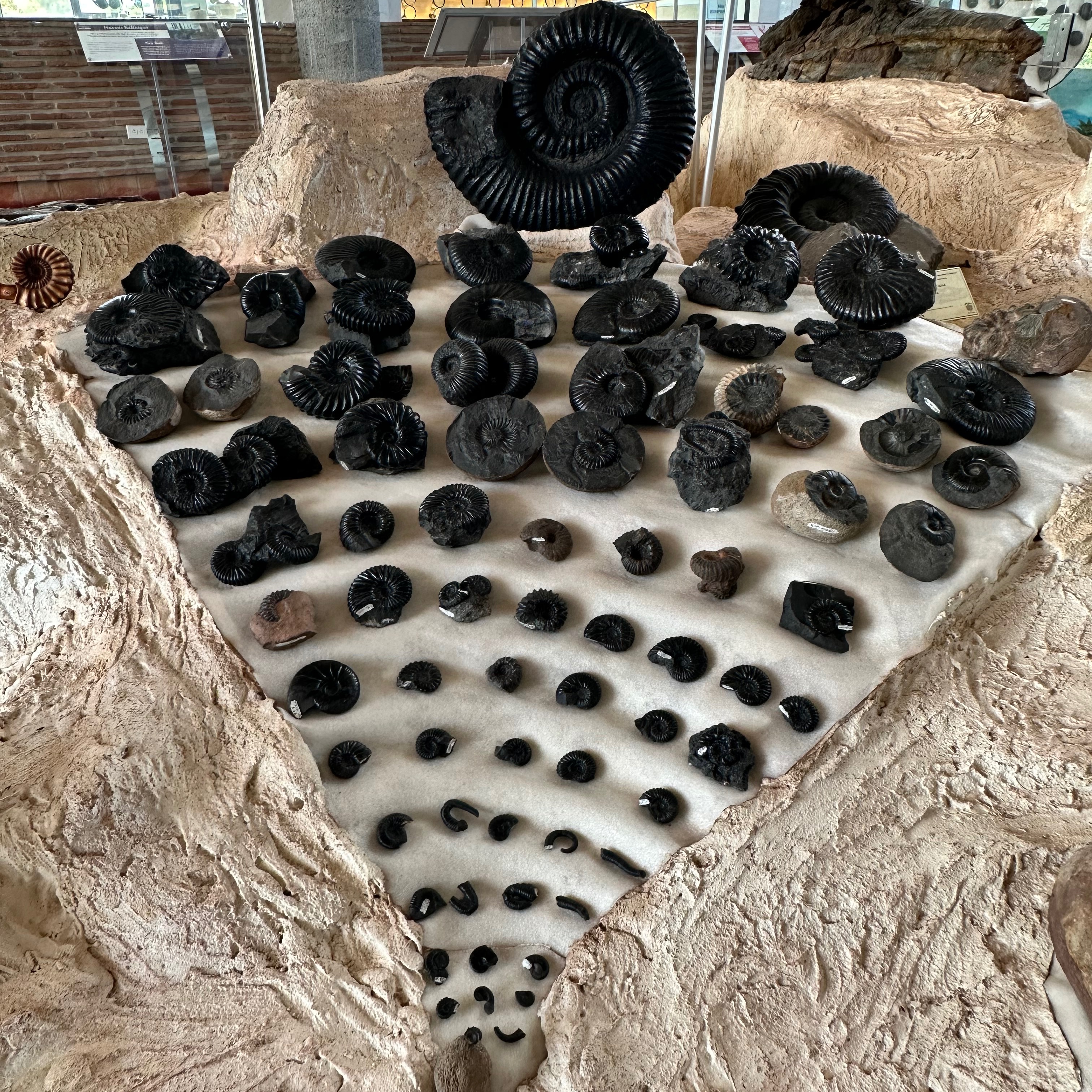Hyper-Apex Predators: Colombian Fossils Reveal Big Reptilians Atop Ancient Marine Food Chain
12:16 minutes


The Paja Formation, located in central Colombia, is a treasure trove of fossils. The site is integral to scientists’ understanding of ancient creatures who roamed the seas during the Early Cretaceous period, about 130 million years ago.
Now, paleontologists have pieced together the food chain of this marine ecosystem. Surprisingly, they found it supported an additional level of apex predators—think massive marine reptiles—for which there is no modern equivalent.
SciFri producer Kathleen Davis talks with Dirley Cortés, paleontologist at the Centro de Investigaciones Paleontológicas in Colombia and PhD candidate at McGill University’s Redpath Museum, and Dr. Hans Larsson, paleontologist and professor at McGill University’s Redpath Museum. They discuss their fascinating findings, and the importance of better understanding this part of the fossil record.


Dirley Cortés is a paleontologist in the Centro de Investigaciones Paleontológicas and a PhD candidate at McGill University’s Redpath Museum in Montreal, Canada.
Dr. Hans Larsson is a paleontologist and professor at McGill University’s Redpath Museum in Montreal, Canada.
SWAPNA KRISHNA: This is Science Friday. I’m Swapna Krishna.
KATHLEEN DAVIS: And I’m Kathleen Davis. A bit later in the hour, we’ll talk about what we can learn about planets from visiting a metal asteroid. We’ll take you behind the scenes of the Psyche Mission. But first, let’s take a trip back in time to some 130 million years ago. The Paja Formation in Central Colombia is a treasure trove of fossils, helping us better understand the ancient creatures who roamed the seas during the early Cretaceous period.
Now, paleontologists have pieced together the food chain of this marine ecosystem. And they found an additional level of apex predators, which are made up of massive marine reptiles. There is no modern equivalent to this.
Joining me now to tell us more about their fascinating findings are my guests, Dirley Cortés, paleontologist at the Centro de Investigaciones Paleontológicas based in Colombia and PhD candidate at McGill University’s Redpath Museum based in Montreal, Canada, and Dr. Hans Larsson, paleontologist and professor at McGill University’s Redpath Museum, also based in Montreal. Welcome both of you to Science Friday.
HANS LARSSON: Thanks for having us.
DIRLEY CORTÉS: Thank you.
KATHLEEN DAVIS: So Dirley, let’s start with some basics. What is this Paja Formation? And why is it so special? For those of us who just aren’t familiar.
DIRLEY CORTÉS: So the Paja Formation is a shallow marine sedimentary sequence in Colombia that has many, many amazing fossils, such as plesiosaurs, ichthyosaurs, turtles, and fish. And we are developing our main research with this material from the Paja Formation.
KATHLEEN DAVIS: Can you give us a sense of how big this formation is?
DIRLEY CORTÉS: OK, so the Paja Formation outcrops in Central Colombia, and one of the richest outcrops is located in Villa de Leyva, where I was born. And the Paja Formation is quite big. It has many, many interesting marine reptile material. And we’ve been prospecting the formation for many years now.
KATHLEEN DAVIS: And as you said, you actually grew up in the town where this fossil formation was discovered. So what does it mean for you for your hometown to be a source of such an amazing scientific discovery?
DIRLEY CORTÉS: It’s just a dream come true. I got a chance to work with this material from my hometown Villa de Leyva. And it’s just amazing. I think it’s a big privilege for me to be able to do research there.
KATHLEEN DAVIS: So Hans, why is it so important to understand this marine ecosystem during this early Cretaceous period?
HANS LARSSON: The life that we have today, like the marine ecosystems, are pretty complex. We have whales, fishes, whole cadre of animals living in the seas and create this incredibly complex ecosystem. And if you go back, let’s say, about 300 million years ago, it was certainly not the case.
And sometime in between that, there was this phenomenon called the Mesozoic marine revolution, where everything sort of transformed into something that we might recognize today. And the importance of looking at this site in particular is that not only is it so amazingly fossiliferous, lots and lots of specimens and high diversity. But it’s also kind of a midpoint in that trajectory. So the importance of looking at it is to see how we can start to understand how this Mesozoic marine revolution happened in the seas.
KATHLEEN DAVIS: So part of this research was looking at this food chain in this early Cretaceous period. Dirley, how does this food chain compare to modern marine ecosystems?
DIRLEY CORTÉS: So Paja the formation biota is really complex, really diverse. And we have no analog for this marine ecosystem. So modern ecosystems, such as the Caribbean system, has up to six trophic levels. But the Paja Formation may have had even seven or more, so one more trophic level happening at the top of the food chain. So in terms of ecosystems structure, we have some similarities, but the top of the chain is completely different between these two ecosystems.
KATHLEEN DAVIS: So I’m really interested to learn more about these huge marine reptiles that were at the very top of this food chain. Dirley, can you tell me a little bit about these creatures?
DIRLEY CORTÉS: Yeah so these were the scariest marine reptiles ever. So we have in this ecosystem plesiosaurs, ichthyosaurs, fish, sharks, crocodylomorphs. So these were large-bodied marine reptiles, or marine vertebrates. And they were living or interacting with each other in ways that we don’t comprehend quite well. But we are exploring how this ecosystem may have looked like back in time. So since we don’t have any analogs for these marine organisms, this is just a good opportunity to look at complexity and stability for these marine ecosystems.
KATHLEEN DAVIS: I want to learn a little bit more about these terrifying marine reptiles. Help me imagine them. Did they all look kind of similar? Were they all different?
DIRLEY CORTÉS: So the plesiosaurs, they were of two kinds, one which is the short-necked plesiosaurs, which were really scary, huge. And they had these really large teeth. And the other type are the elasmosaurs with a really long neck. And then we have the ichthyosaurs, which were like a tuna-shaped marine reptile. So we discovered this large tylosaurus, which is a fully marine crocodylomorph with about 10 meters in length.
KATHLEEN DAVIS: 10 meters in length is very long for what I imagine was a very scary-looking creature. Hans, how does this extra level of the food chain affect the rest of the ecosystem?
HANS LARSSON: This extra level of food chain, it affects it because it’s adding this level of complexity that we just don’t see today. And so imagine what it would take to feed an animal that has a skull of 2.5 meters long, teeth the size of your hands. And they’re feeding on organisms that are probably smaller than them but not much smaller because their skulls are just so enormous.
And their prey has been feeding on something else, which is also pretty large by today’s standards. And you can just keep on walking down that food chain. And what you come up with is this incredibly rich and complex ecosystem that is supporting these enormous hyper-apex predators that we just don’t have today.
KATHLEEN DAVIS: Are there things missing from that ancient food chain that we have now?
HANS LARSSON: So it turns out that, in constructing this food web and then comparing it to something that we thought would be a pretty good analog, a natural Caribbean marine food web, turns out we’re missing almost everything. So almost all of the medium to small fishes, almost all of the ground dwelling or benthic invertebrates, they’re not in the fossil record yet. Every time a piece of something in that category is found, it turns out to be a new species in that formation. And so think it’s just going to take a little bit more time, maybe a few more generations of fossil hunting, to really flesh out the rest of this ecosystem.
KATHLEEN DAVIS: So you think that they did exist but we just haven’t found evidence of them, is that right?
HANS LARSSON: I think that’s right. And the reason why I’m quite sure of that is that other formations from different continents but around the same time do preserve these kinds of animals. And so it’s just a matter of time until we can find that in this particular formation, which is always a problem of paleontology because there’s always going to be some kind of bias, usually because the fossils aren’t preserved the same way or maybe the paleontologists don’t have the same eye for it. If you’re walking and you cross by a two and a half meter skull versus a little two centimeter crab, what are you going to find first?
KATHLEEN DAVIS: Right. [LAUGHS] More exciting probably to find the several-meter skull. And so another interesting thing about this work is that you found so many different species of ammonites, which are these extinct mollusk creatures. Can they help us better understand this ecosystem?
HANS LARSSON: The ammonites in the Paja Formation are world famous. There’s over 100 species in this formation. You cannot walk in places without stepping on ammonite. It’s that rich.
But we have no analog today. The closest thing would be something like the nautilus, which only superficially looks like ammonites. And these ammonites were probably quite diverse in their ecology. Some may have been filter feeding. Some may have been predatory. Some may have been scavenging.
But they’re everywhere. That might be something that is really unique to this system. It might be driving this sort of intense food web. What they do is they fill in, we discovered, kind of like a middle tier of the food web. And so they’re feeding on something probably quite rich underneath them, and they’re also providing something quite rich in terms of their predators above them, just because of their amazing diversity.
KATHLEEN DAVIS: So sequencing this food chain, I would imagine, is kind of just one piece of this puzzle of understanding this formation and this ancient ecosystem. Dirley, what are the questions that you hope to answer next?
DIRLEY CORTÉS: So we know what is missing in the Paja. And so we don’t know exactly why. So the lower levels in the food chain are missing, and it would be really interesting to explore what is specifically is– what is going on at the base of the food chain in terms of the economy, in terms of biodiversity, and in terms of ecological structure to be able to support higher trophic levels? So that would be one interesting question.
And another would be how energy is distributed throughout the system. So there are plenty of questions we are asking now. But we just need more prospecting to be able to do so.
KATHLEEN DAVIS: Hans, any questions that you are hoping to find the answer to in the future?
HANS LARSSON: That’s a loaded question. I think what this does is it just exposes the tip of the iceberg on what’s possible here. And so while the Paja Formation is an intensely rich and exciting fossil deposit– and Dirley was talking about how that could be expanded, and we just keep on going further and further in that one formation. We can start looking also around it, both geographically around it and stratigraphically above and below it, and think about how these really intensely complex ecosystems came to be that way and why they aren’t like that anymore.
KATHLEEN DAVIS: Well, that is all the time that we have for now. I would like to thank my guests, Dirley Cortés, paleontologist at the Centro de Investigaciones Paleontológicas based in Colombia and also a PhD candidate at McGill University’s Redpath Museum, based in Montreal, Canada, and Dr. Hans Larsson, paleontologist and professor at McGill University’s Redpath Museum, also based in Montreal. Thank you both so much.
HANS LARSSON: Thank you. Our pleasure.
DIRLEY CORTÉS: Thank you.
Copyright © 2023 Science Friday Initiative. All rights reserved. Science Friday transcripts are produced on a tight deadline by 3Play Media. Fidelity to the original aired/published audio or video file might vary, and text might be updated or amended in the future. For the authoritative record of Science Friday’s programming, please visit the original aired/published recording. For terms of use and more information, visit our policies pages at http://www.sciencefriday.com/about/policies/
Shoshannah Buxbaum is a producer for Science Friday. She’s particularly drawn to stories about health, psychology, and the environment. She’s a proud New Jersey native and will happily share her opinions on why the state is deserving of a little more love.
Santiago Flórez is Science Friday’s community manager. He is a former teacher, anthropologist and journalist.
Kathleen Davis is a producer and fill-in host at Science Friday, which means she spends her weeks researching, writing, editing, and sometimes talking into a microphone. She’s always eager to talk about freshwater lakes and Coney Island diners.